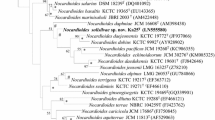Abstract
A short coccoid-rod-shaped, nonmotile actinobacteria strain MSL-11T was isolated from soil in Bigeum Island, Korea. A polyphasic study was undertaken to establish the taxonomic position of this strain. Phylogenetic analysis based on the 16S rRNA gene sequence revealed that strain MSL-11T forms an evolutionary lineage within the radiation of the genus Nocardioides. The cell wall peptidoglycan of strain MSL-11T contained ll-diaminopimelic acid, indicating wall chemotype I. The predominant menaquinone was MK-8(H4). Strain MSL-11T had a cellular fatty acid profile containing straight-chain, branched, unsaturated, and 10-methyl fatty acids, with iso-C16:0 as a major fatty acid component detected. The DNA G + C content of the strain was 71.8 mol%. Comparative 16S rRNA gene sequencing revealed that the strains constituted a distinct subclade within the genus Nocardioides, displaying a 16S rRNA gene sequence similarity of about 95.68% with Nocardioides jensenii DSM 20641T. On the basis of both phenotypic and phylogenetic evidence, the strain is separated from previously described Nocardioides species and should be assigned to represent a novel species of the genus Nocardioides, for which the name Nocardioides dilutes sp. nov. is proposed. The type strain is strain MSL-11T (= KCTC 19288T = DSM 19318T).


Similar content being viewed by others
References
Bakermans C, Madsen EL (2002) Diversity of 16S rDNA and naphthalene dioxygenase genes from coal-tar-waste-contaminated aquifer waters. Microbiol Ecol 44:95–106
Cowan ST, Steel KJ (1965) Manual for the identification of medical bacteria. Cambridge University Press, London
Felsenstein J (2002) PHYLIP (phylogeny inference package), version 3.6a. Distributed by the author. Department of Genome Sciences, University of Washington, Seattle
Kimura M (1980) A simple method for estimating evolutionary rates of base substitutions through comparative studies of nucleotide sequences. J Mol Evol 16:111–120
Komagata K, Suzuki K (1987) Lipids and cell-wall analysis in bacterial systematics. Methods Microbiol 19:161–203
Lanyi B (1987) Classical and rapid identification methods for medically important bacteria. Methods Microbiol 19:1–67
Lechevalier MP, Lechevalier HA (1970) Chemical composition as a criterion in the classification of aerobic actinomycetes. Int J Syst Bacteriol 20:435–443
Minnikin DE, O’Donnell AG, Goodfellow M et al (1984) An integrated procedure for the extraction of bacterial isoprenoid quinones and polar lipids. J Microbiol Methods 2:233–241
Park YH, Yoon JH, Shin YK et al (1999) Classification of ‘Nocardioides fulvus’ IFO 14399 and Nocardioides sp. ATCC 39419 in Kribbella gen. nov., as Kribbella flavida sp. nov. and Kribbella sandramycini sp. nov. Int J Syst Bacteriol 49:743–752
Prauser H (1976) Nocardioides, a new genus of the order Actinomycetales. Int J Syst Bacteriol 26:58–65
Prauser H (1984) Nocardioides luteus spec.nov. Zeitschr Allgem Mikrobiol 24:647–648
Sasser M (1990) Identification of bacteria by gas chromatography of cellular fatty acids. USFCC News Lett 20:1–6
Suzuki K, Komagata K (1983) Pimelobacter gen. nov., a new genus of coryneform bacteria with ll-diaminopimelic acid in the cell wall. J Gen Appl Microbiol 29:59–71
Tamaoka M, Komagata K (1984) Determination of DNA base composition by reversed-phase high-performance liquid chromatography. FEMS Lett 25:125–128
Thompson JD, Higgins DG, Gibson TJ (1994) CLUSTAL W: improving the sensitivity of progressive multiple sequence alignment through sequence weighting, position-specific gap penalties and weight matrix choice. Nucleic Acids Res 22:4673–4680
Yoon JH, Park YH (2006) The genus Nocardioides. In: Martin D, Stanley F, Rosenberg E (eds) Prokaryotes. A handbook on the biology of bacteria, vol 3. Karl-Heinz Schleifer & Stackebrandt, New York, pp 1099–1113
Yoon JH, Kim IG, Lee MH, Lee CH, Oh TK (2005a) Nocardioides alkalitolerans sp. nov., isolated from an alkaline serpentinite soil in Korea. Int J Syst Evol Microbiol 55:809–814
Yoon JH, Kim IG, Lee MH, Oh TK (2005b) Nocardioides kribbensis sp. nov., isolated from an alkaline soil. Int J Syst Evol Microbiol 55:1611–1614
Yoon JH, Lee CH, Oh TK (2006) Nocardioides lentus sp. nov., isolated from an alkaline soil. Int J Syst Evol Microbiol 56:271–275
Acknowledgments
This work was supported by the 21C Frontier Microbial Genomics and Application Centre Program Korean Ministry of Science & Technology (MOST) and Korea Foundation for International Cooperation of Science & Technology (KICOS) through a grant provided by MOST in the Global Partnership Program (No. M60602000001-06E0200-00100), Republic of Korea.
Author information
Authors and Affiliations
Corresponding author
Rights and permissions
About this article
Cite this article
Dastager, S.G., Lee, JC., Ju, YJ. et al. Nocardioides dilutes sp. nov. Isolated from Soil in Bigeum Island, Korea. Curr Microbiol 56, 569–573 (2008). https://doi.org/10.1007/s00284-008-9125-9
Received:
Accepted:
Published:
Issue Date:
DOI: https://doi.org/10.1007/s00284-008-9125-9




